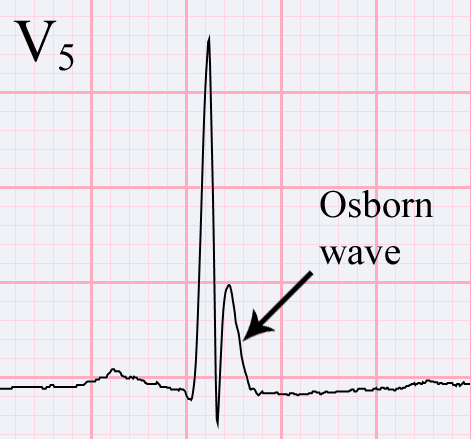Hypothermia electrocardiogram
 From Wikidoc - Reading time: 2 min
From Wikidoc - Reading time: 2 min
|
Hypothermia Microchapters |
|
Diagnosis |
|---|
|
Treatment |
|
Case Studies |
|
Hypothermia electrocardiogram On the Web |
|
American Roentgen Ray Society Images of Hypothermia electrocardiogram |
|
Risk calculators and risk factors for Hypothermia electrocardiogram |
Editor-In-Chief: C. Michael Gibson, M.S., M.D. [1]
Overview[edit | edit source]
Hypothermia is characterized on the EKG by sinus bradycardia, PR prolongation, QT prolongation, QRS prolongation and Osborn waves.
Electrocardiogram[edit | edit source]
Rate[edit | edit source]
There is a slowing of the sinus rate.
Rhythm[edit | edit source]
About 50 to 60% of these patients develop atrial fibrillation. VF may also occur.
PR Interval[edit | edit source]
There is prolongation of the PR interval.
QRS Interval[edit | edit source]
There is prolongation of the QRS which is often due to the appearance of the J wave
QT Interval[edit | edit source]
There is prolongation of the QT interval
Osborn Waves[edit | edit source]
The most typical finding is the appearance of the Osborne J wave, an extra deflection between the QRS complex and the T wave. Osborn waves are positive deflections occurring at the junction between the QRS complex and the ST segment, where the S point, also known as the J joint, has a myocardial infarction-like elevation. Osborn waves are more prominent in the left precordial leads. They increases in size with decreasing temperature. They are caused by a current of injury, delayed ventricular depolarization, or early repolarization.
Osborn waves may first appear on the ECG for temperatures less than 91.4 degrees Fahrenheit (33 degrees Celsius), and consistently appear when when the temperature falls below 25 degrees Centigrade.
There is variability in the morphology of Osborn waves as all J wave deflections do not look alike. Some Osborn waves are merely elevations of ST segments in leads V1 and V2, whereas others are of the "spike-and-dome" variety. Given the variability in morphology, a variety of mechanisms may be responsible for the size and shape of J wave deflections.
Shown below is an example of the "spike and dome" variant of the Osborn wave:

Shown below is an Osborn wave in an 81-year-old male with a core temperature 89.5 degrees F (31.94 C):

Electrocardiographic Examples[edit | edit source]
Examples of Osborn Waves in the Setting of Hypothermia[edit | edit source]
Shown below is the 12 lead ECG of a patient with a body temperature of 32 degrees Celsius. Note the sinus bradycardia, the prolonged QT interval (QTc is not prolonged) and the Osborn J wave, most prominently in leads V2-V5:

Shown below is An ECG of a patient with a body temperature of 28 degrees Celsius:

Shown below are Osborn J waves due to hypothermia:

Shown below are Osborn J waves due to hypothermia:

References[edit | edit source]
 KSF
KSF